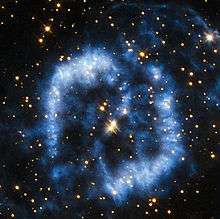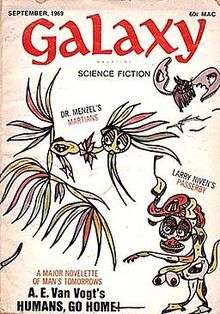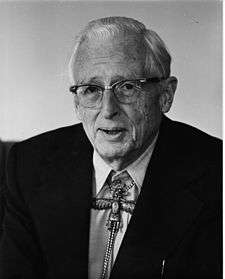Donald Howard Menzel
| Donald Howard Menzel | |
|---|---|
|
Donald Howard Menzel by Babette Whipple | |
| Born |
April 11, 1901 Florence, Colorado |
| Died |
December 14, 1976 (aged 75) Boston, Massachusetts |
| Nationality | United States |
| Fields | Astronomy, Astrophysics, Star Formation |
| Institutions | Lick Observatory, Harvard, Harvard–Smithsonian Center for Astrophysics |
| Alma mater | University of Denver, Princeton |
| Doctoral advisor | Henry Norris Russell |
| Doctoral students |
Jesse L. Greenstein Richard Nelson Thomas |
Donald Howard Menzel (April 11, 1901 – December 14, 1976) was one of the first theoretical astronomers and astrophysicists in the US. He discovered the physical properties of the solar chromosphere, the chemistry of stars, the atmosphere of Mars, and the nature of gaseous nebulae.[1][2] The minor planet 1967 Menzel was named in his honor.[3]
Biography
Born in Florence, Colorado in 1901 and raised in Leadville, he learned to read very early, and soon could send and receive messages in Morse code, taught by his father. He loved science and mathematics, collected ore and rock specimens, and as a teenager he built a large (and probably hazardous) chemistry laboratory in the cellar. He made a radio transmitter – no kits in those days – and qualified as a radio ham. He was an Eagle Scout, specializing in cryptanalysis, as well as an outdoorsman, hiking and fly fishing throughout much of his life. He married Florence Elizabeth Kreager on June 17, 1926 and had two daughters (Suzanne Kay and Elizabeth Ina).
At 16, he enrolled in the University of Denver to study chemistry. His interest in astronomy was aroused through a boyhood friend (Edgar Kettering), through observing the solar eclipse of June 8, 1918, and through observing the eruption of Nova Aquilae 1918 (V603 Aquilae). He graduated from the University of Denver in 1920 with an A.B. degree in chemistry and an A.M. degree in chemistry and mathematics in 1921. He also found summer positions in 1922, 1923, and 1924 as research assistant to Harlow Shapley at the Harvard College Observatory. At Princeton University he acquired a second A.M. degree in astronomy in 1923, and in 1924 a Ph.D. in astrophysics for which his advisor was Henry Norris Russell, who inspired his interest in theoretical astronomy. After teaching two years at the University of Iowa and Ohio State University, in 1926 he was appointed assistant Professor at Lick Observatory in San Jose CA, where he worked for several years. In 1932 he moved to Harvard. During World War II Menzel was asked to join the Navy as Lieut. Commander, to head a division of intelligence, where he used his many-sided talents, including deciphering enemy codes. Even until 1955, he worked with the Navy improving radio-wave propagation by tracking the Sun's emissions and studying the effect of the aurora on radio propagation for the Department of Defense (Menzel & Boyd, p. 60[4]). Returning to Harvard after the war, he was appointed acting director of the Harvard Observatory in 1952, and was the full director from 1954 to 1966. The term "Menzel Gap" was used to refer to the absence of astronomical photographic plates during a brief period in the 1950s when plate-making operations were temporarily halted by Menzel as a cost-cutting measure.[5] He retired from Harvard in 1971. From 1964 to his death, Menzel was a U.S. State Department consultant for Latin American affairs.
He received honorary A.M. and Sc.D. degrees from Harvard University in 1942 and the University of Denver in 1954 respectively. From 1946-1948 he was the Vice President of the American Astronomical Society, becoming their President from 1954-1956. In 1965, Menzel was given the John Evans Award of the University of Denver. In May 2001, Harvard-Smithsonian Center for Astrophysics hosted "Donald H. Menzel: Scientist, Educator, Builder," a symposium in honor of the 100th anniversary of the birth of Donald H. Menzel.
Menzel is renowned for traveling with expeditions to view solar eclipses to obtain scientific data. On 19 June 1936, he led the Harvard-MIT expedition to the steppes of Russia (at Ak Bulak in southwestern Siberia) to observe a total eclipse. For the 9 July 1945 eclipse, he directed the Joint U.S.-Canadian expedition to Saskatchewan, although they were clouded out. Menzel observed many total solar eclipses, often leading the expeditions, including Catalina, California (10 September 1923, cloudy), Camptonville, California (28 April 1930), Fryeburg, Maine (31 August 1932), Minneapolis-St. Paul, Minnesota (30 June 1954), the Atlantic coast of Massachusetts (2 October 1959), northern Italy (15 February 1951), Orono, Maine (20 July 1963, cloudy), Athens/Sunion Road, Greece (20 May 1966), Arequipa, Peru (12 November 1966), Miahuatlan, south of Oaxaca, Mexico (7 March 1970), Prince Edward Island Canada (10 July 1972), and western Mauritania (30 June 1973), in addition to the other three mentioned above.[6] He proudly held the informal record for greatest number of observed solar eclipses, a "title" later broken by his student, colleague, and co-author Jay Pasachoff.

In the late 1930s he built an observatory for solar research at Climax, CO, using a telescope that mimicked a total eclipse of the sun, allowing him and his colleagues to study the sun's corona and to film the spouting flames, called prominences, emitted by the Sun. Menzel initially performed solar research, but later concentrated on studying gaseous nebulae. His work with Lawrence Aller and James Gilbert Baker defined many of the fundamental principles of the study of planetary nebulae. He wrote the first edition (1964) of A Field Guide to the Stars and Planets, part of the Peterson Field Guides. In one of his last papers,[8] Menzel concluded, based on his analysis of the Schwarzschild equations, that black holes do not exist, and he declared them to be a myth.
Beloved by children, he was known to all as Donald Duck: Donald le Canard in France, Pato Donald in Latin America, and Donald Utka in the Soviet Union. He carried on correspondence with many young pen pals, and was known for telling elaborate stories that he invented on the spot. Colleagues were familiar with his "Martians" that he doodled during meetings, which developed into a hobby of making watercolor paintings of alien creatures and scenes, easily identifiable by 3-dimensional "holes" though characters, clouds, and alien spaceships.[9][10]
Menzel and UFOs

In addition to his academic and popular contributions to the field of astronomy, Menzel was a prominent skeptic concerning the reality of UFOs. He authored or co-authored three popular books debunking UFOs: Flying Saucers - Myth - Truth - History (1953),[11] The World of Flying Saucers (1963, co-authored with Lyle G Boyd),[4] and The UFO Enigma (1977, co-authored with Ernest H. Taves).[12] All of Menzel's UFO books argued that UFOs are nothing more than misidentification of prosaic phenomena such as stars, clouds and airplanes; or the result of people seeing unusual atmospheric phenomena they were unfamiliar with. He often suggested that atmospheric hazes or temperature inversions could distort stars or planets, and make them appear to be larger than in reality, unusual in their shape, and in motion. In 1968, Menzel testified before the U.S. House Committee on Science and Astronautics - Symposium on UFOs, stating that he considered all UFO sightings to have natural explanations.
He was perhaps the first prominent scientist to offer his opinion on the matter, and his stature doubtless influenced the mainstream and academic response to the subject. Perhaps Menzel's earliest public involvement in UFO matters was his appearance on a radio documentary directed and narrated by Edward R. Murrow in mid-1950. (Swords, 98)
Menzel had his own UFO experience when he observed a 'flying saucer' while returning on 3 March 1955 from the North Pole on the daily Air Force Weather "Ptarmigan" flight. His account is in both Menzel & Boyd[4] and Menzel & Taves.[12] He later identified it as a mirage of Sirius, but Steuart Campbell claims that it was a mirage of Saturn.[13]
Notes
- ↑ Goldberg, L.; Aller, L. H. (1991). Donald Howard Menzel (PDF). National Academy of Sciences.
- ↑ Gingerich, Owen (May 1977). "Donald H. Menzel". Physics Today. 30 (5): 67–69. Bibcode:1977PhT....30e..96G. doi:10.1063/1.3037558.
- ↑ Schmadel, Lutz D. (2003). Dictionary of Minor Planet Names – (1967) Menzel. Springer Berlin Heidelberg. p. 158. ISBN 978-3-540-29925-7. Retrieved 28 December 2015.
- 1 2 3 Menzel, D. H.; Boyd, L. G. (1963). The World Of Flying Saucers: A Scientific Examination of a Major Myth of the Space Age. Doubleday. LCCN 63012989.
- ↑ Johnson, G. (July 10, 2007). "A Trip Back in Time and Space". The New York Times. Retrieved 2012-04-21.
- ↑ Pasachoff, J. M. (2002). "Menzel and Eclipses". Journal for the History of Astronomy. 33: 139–156. Bibcode:2002JHA....33..139P.
- ↑ "Waving goodbye". Retrieved 7 October 2015.
- ↑ Menzel, D. H. (1976). "Superstars and the black hole myth". Mémoires de la Société Royale des Sciences de Liège. 9: 343–353. Bibcode:1976MSRSL...9..343M.
- ↑ Menzel, Donald (1969). "cover art". Galaxy Science Fiction.
image provided by Icshi.net
- ↑ Epps, Garrett (1970). "Menzel's Martians Frolic". The Harvard Crimson.
- ↑ Menzel, D. H. (1953). Flying Saucers. Harvard University Press. LCCN 52012419.
- 1 2 Menzel, D. H.; Taves, E. H. (1977). The UFO Enigma: The Definitive Explanation of the UFO Phenomenon. Doubleday. ISBN 0-385-03596-9. LCCN 76016255.
- ↑ Campbell, S. (1994). The UFO Mystery Solved. Explicit Books. pp. 61–64. ISBN 0-9521512-0-0.
Sources
- Story, R.; Greenwell, J. R. (1980). "Menzel, Donald H.". The Encyclopedia of UFOs. Doubleday. pp. 229–230. ISBN 0-385-13677-3.
- Pasachoff, J. (2002). "Menzel and Eclipses". Journal for the History of Astronomy. 33: 139–156. Bibcode:2002JHA....33..139P.
- Swords, M. D. (2000). "UFOs, the Military, and the Early Cold War Era". In Jacobs, D. M. UFOs and Abductions: Challenging the Borders of Knowledge. University Press of Kansas. pp. 82–121. ISBN 0-7006-1032-4.
- Bogdan, T. J. (2007). "Menzel, Donald Howard". The Biographical Encyclopedia of Astronomers. 13. pp. 769–770. doi:10.1007/978-0-387-30400-7_939. ISBN 978-0-387-31022-0.
- "Papers of Donald Howard Menzel: An inventory". Harvard University Library. 2005.
Publications
Menzel published over 270 scientific and other papers.
- Menzel, D. H. (1924). A Study of Line Intensities in Stellar Spectra (Ph.D Thesis). Princeton University.
- Menzel, D. H. (1926). "The Atmosphere of Mars". The Astrophysical Journal. 63: 48–59. Bibcode:1926ApJ....63...48M. doi:10.1086/142949.
- Menzel, D. H. (1927). "Pressure Decomposition as a Source of Solar Energy". Science. 65 (1687): 422–3. Bibcode:1927Sci....65..422M. doi:10.1126/science.65.1687.422-a. PMID 17771152.
- Menzel, D. H. (1927). "The Source of Solar Energy". Science. 65 (1688): 431–8. Bibcode:1927Sci....65..431M. doi:10.1126/science.65.1688.431. PMID 17736928.
- Menzel, D. H. (1931). Stars and Planets: Exploring the universe. The University Society. LCCN 32000650.
- Menzel, D. H. (1931). "A Study of the Solar Chromosphere". Publications of the Lick Observatory. 17 (1): 1–303. Bibcode:1930PLicO..17....1M.
- Menzel, D. H. (1932). "Blast of Giant Atom Created Our Universe". Popular Science. pp. 28–30.
- Menzel, D. H. (1933). "A Simple Derivation of the Dissociation Formula". Proceedings of the National Academy of Sciences. 19 (1): 40–4. Bibcode:1933PNAS...19...40M. doi:10.1073/pnas.19.1.40. PMC 1085875
 . PMID 16587746.
. PMID 16587746. - Menzel, D. H.; Payne, C. H. (1933). "On the Interpretation of Nova Spectra". Proceedings of the National Academy of Sciences. 19 (7): 641–8. Bibcode:1933PNAS...19..641M. doi:10.1073/pnas.19.7.641. PMC 1086128
 . PMID 16577542.
. PMID 16577542. - Boyce, J. C.; Menzel, D. H.; Payne, C. H. (1933). "Forbidden Lines in Astrophysical Sources". Proceedings of the National Academy of Sciences. 19 (6): 581–91. Bibcode:1933PNAS...19..581B. doi:10.1073/pnas.19.6.581. PMC 1086096
 . PMID 16587791.
. PMID 16587791. - Menzel, D. H.; Marshall, R. K. (1933). "Neon Absorption Lines in Stellar Spectra". Proceedings of the National Academy of Sciences. 19 (10): 879–81. Bibcode:1933PNAS...19..879M. doi:10.1073/pnas.19.10.879. PMC 1086222
 . PMID 16587803.
. PMID 16587803. - Russell, H. N.; Menzel, D. H. (1933). "The Terrestrial Abundance of the Permanent Gases". Proceedings of the National Academy of Sciences. 19 (12): 997–1001. Bibcode:1933PNAS...19..997R. doi:10.1073/pnas.19.12.997. PMC 1086270
 . PMID 16587829.
. PMID 16587829. - Menzel, D. H. (1938). Stars and Planets: Exploring the universe. The University Society. LCCN 38038813.
- Menzel, D. H. (1948). Elementary Manual of Radio Propagation. Prentice-Hall. LCCN 48002219.
- Menzel, D. H. (1949). Our Sun. Blakiston Co. LCCN 59012975.
- Menzel, D. H. (1950). "Origin of Sunspots". Nature. 166 (4209): 31–2. Bibcode:1950Natur.166...31M. doi:10.1038/166031b0. PMID 15439102.
- Menzel, D. H. (1953). Mathematical Physics. Prentice-Hall. LCCN 53007714.
- Menzel, D. H. (1953). Flying Saucers. Harvard University Press. LCCN 52012419.
- Menzel, D. H. (1955). Fundamental Formulas of Physics. Prentice-Hall. LCCN 55014512.
- Menzel, D. H. (1957). The Edge of the Sun. Smithsonian Institution. LCCN 58002324.
- Menzel, D. H. (1960). The Radio Noise Spectrum. Harvard University Press. LCCN 60007997.
- Menzel, D. H. (1960). Fundamental Formulas of Physics. Dover Publications. LCCN 60051149.
- Menzel, D. H.; Jones, H. M.; Boyd, L. G. (1961). Writing a Technical Paper. McGraw-Hill. LCCN 61007581.
- Menzel, D. H. (1962). "Physics of the Solar Chromosphere. Richard N. Thomas and R. Grant Athay. Interscience (Wiley), New York, 1961. x + 422 pp. Illus. $15.50". Science. 137 (3533): 848–9. doi:10.1126/science.137.3533.848-a. PMID 17787332.
- Menzel, D. H.; Boyd, L. G. (1963). The World of Flying Saucers. Doubleday. LCCN 63012989.
- Menzel, D. H.; Yü, C. S. (1970). Astronomy. Random House. LCCN 70127542.
- Martin, M. E.; Menzel, D. H. (1964). The Friendly Stars. Dover Publications. ISBN 0-486-21099-5.
- Menzel, D. H.; Pasachoff, J. M. (1970). "The Outer Corona at the Eclipse of March 7, 1970". Nature. 226 (5251): 1143–4. Bibcode:1970Natur.226.1143M. doi:10.1038/2261143a0. PMID 16057713.
- Menzel, D. H.; Taves, E. H. (1977). The UFO Enigma. Doubleday. ISBN 0-385-03596-9.
He also wrote a popular account of astronomy: A Field Guide to the Stars and Planets Including the Moon, Satellites, Comets and Other Features of the Universe (1975); 2nd edition (1984) by Menzel and Pasachoff, 3rd edition (1992) by Pasachoff and Menzel, 4th edition (2000) by Pasachoff.
External links
- Donald Howard Menzel at the Mathematics Genealogy Project
- UFOs: Fact or Fiction? by Donald H. Menzel (1968)

